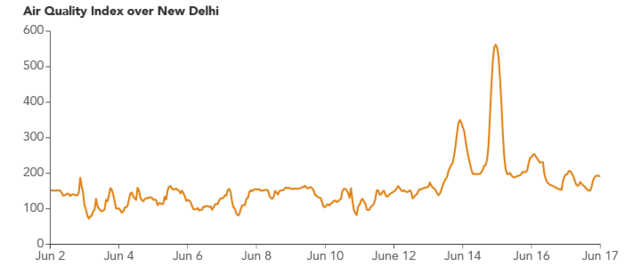English: As weather grows hot and the winds pick up in late spring, dust storms start to blow across India. The most intense dust storms usually occur just before monsoon season. But this year has been worse than usual.
“Every year in April, May, and June, we see dust loading,” said Hiren Jethva, who studies aerosols with the Universities Space Research Association at NASA's Goddard Space Flight Center. “This year’s dust season, including this most recent event, has been unusual in terms of the intensity.”
In May 2018, India experienced a period of extreme weather, including intense dust and lightning storms. A new burst of storms from June 12-15 over New Delhi led to severe pollution, causing citizens to suffer through poor breathing conditions.
A dust storm originated in the western state of Rajasthan on June 12, 2018, as high winds kicked up dust from the Thar desert. Over the next few days, the dust traveled across north-central India. This image was acquired on June 14 by the Visible Infrared Imaging Radiometer Suite (VIIRS) on the Suomi NPP satellite. The dust was trapped between mountain ranges and appears in the shape of upside down “v” on the image.
Jethva expected the dust to continue moving southeast toward the Bay of Bengal, but instead it stayed concentrated over the northern plain for another day because the south-moving dust was met by strong winds blowing northwest from the Bay of Bengal. Air quality around New Delhi was at its worst on June 15, 2018.
The graph below shows air quality conditions (particulate matter and ground-level ozone) over New Delhi as reported by the U.S. Embassy and Consulates' air quality monitors. Hazardous levels of air quality are classified with measurement values of from 301 to 500. New Delhi’s air quality index on June 15th was around 518. The local government advised people to stay inside and deployed fire brigades to sprinkle water across the city.
acquired June 2 - 17, 2018
Along with the strong southwesterly winds lifting dust into the air, one reason for the intense dust storm is that the first spell of monsoon rain has been delayed in northern India this year. Normally, the rains help dampen and remove dust, cleansing the air. The India Meteorological Department is forecasting light showers in New Delhi, which may alleviate the air pollution.
Deutsch: Wenn das Wetter heiß wird und die Winde am Ende des Frühlings zunehmen, fangen die Staubstürme an, über Indien zu wehen. Die intensivsten Staubstürme treten üblicherweise kurz vor der Monsunsaison auf, doch in diesem Jahr (2018) war diese schlimmer als üblich.
“Jedes Jahr im April, May und Juni, sehen wir eine Zunahme des Staubgehaltes,” sagte Hiren Jethva, der Studien über Aerosole an der Universities Space Research Association at NASA's Goddard Space Flight Center durchführt. “Die Staubsaison in diesem Jahr, einschließlich dieses letzten Ereignisses, war in Hinsicht auf die Intensität ungewöhnlich.”
Im Mai 2018 erlebte Indien eine Periode extremen Wetters, einschließlich starker Staub- und Gewitterstürme. Ein neuer Ausbruch von Stürmen führte von 12. bis 15. Juni zu starker Verschmutzung, wodurch die Bewohner der Stadt an schlechten Atembedingungen litten.
Ein Staubsturm hatte seinen Ursprung am 12. Juni im westliche Bundesstaat Rajasthan, wo der starke Wind Staub von der Wüste Thar hochwirbelte. Im verlauf der folgenden Tage wanderte der Staub über den nördlich-zentralen Teil Indiens. Dieses Bild wurde angefertigt mithilfe der Visible Infrared Imaging Radiometer Suite (VIIRS) auf dem Suomi-NPP-Satelliten. Der Staub war eingeschlossen zwischen Bergketten und erscheint auf dem Bild in der Form eines umgedrehten “V”.
Jethva erwartete, dass der Staub weiter in Richtung Südosten auf den Golf von Bengalen wanderte, doch stattdessen konzentrierte er sich noch einen weiteren Tag über der nördlichen Ebene, weil der südlich ziehende Staub mit starken Winden aus dem Golf von Bengalen zusammentraf, der nach Nordwesten wehte. Am 15. Juni war die Luftqualität um New Delhi am schlechtesten.
Die Grafik zeigt die Bedingungen der Luftqualität über New Delhi wie sie von den Meßgeräten im Programm der US-amerikanischen Botschaften und Konsulate aufgezeichnet wurde. Als lebensgefährliche Niveaus der Luftqualität gelten Meßwerte zwischen 301 und 500. New Delhis Luftqualitätsindex am 15. Juni bewegte sich um 518. Die örtliche Regierung empfahl den Bewohnern, im Inneren von Gebäuden zu bleiben und setzte fünf Feuerwehreinheiten ein, um Wasser in der Stadt zu verspritzen.
Abgesehen von den starken Südwestwinden, die den Staub aufwirbelten, ist ein Grund für die intensive Staubentwicklung, daß die erste Runde des Monsunregens im nördlichen Indien in diesem Jahr verspätet war. Normalerweise hilft der Regen, den Staub zu binden und wegzuspülen und reinigt so die Luft. Die vom India Meteorological Department am 17. Juni 2018 vorhergesagten leichten Schauer in New Delhi könnten die Luftverschmutzung verringern.






